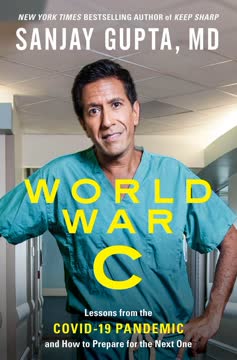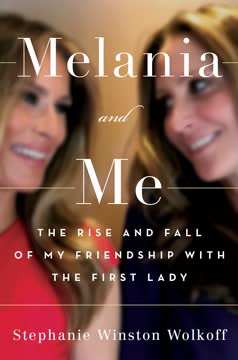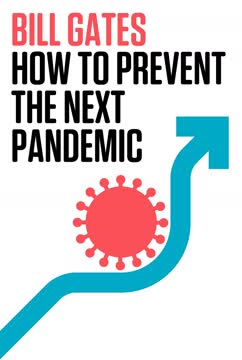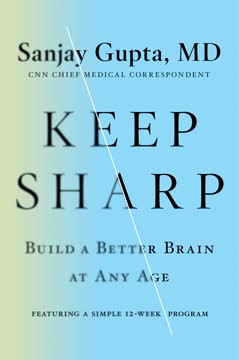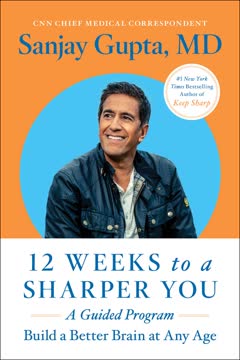Key Takeaways
1. The COVID-19 pandemic was a wake-up call for global health preparedness
"We should never be caught off guard again."
Unprepared for the invisible enemy. Despite warnings from public health experts, the world was largely unprepared for the COVID-19 pandemic. Many countries, including the United States, lacked adequate stockpiles of personal protective equipment, testing capabilities, and coordinated response plans. This unpreparedness led to overwhelmed healthcare systems, economic disruptions, and countless preventable deaths.
Lessons learned. The pandemic exposed critical weaknesses in global health security and highlighted the need for:
- Robust early warning systems
- Increased investment in public health infrastructure
- Enhanced coordination between local, national, and international health authorities
- Improved pandemic preparedness plans and regular simulations
- Greater emphasis on preventive measures and community resilience
2. Early warnings and simulations predicted the pandemic's impact
"Crimson Contagion exposed the shortcomings of our response system that eventually, and eerily, played out in reality."
Unheeded warnings. Numerous simulations and expert warnings predicted a global pandemic's potential impact years before COVID-19. These exercises, such as "Crimson Contagion" in 2019, accurately forecasted many challenges that would arise during the actual pandemic, including:
- Shortages of medical supplies and equipment
- Confusion over federal and state responsibilities
- Economic disruptions and societal upheaval
Failure to act. Despite these clear warnings, many governments and institutions failed to adequately prepare or allocate resources for pandemic readiness. This lack of action stemmed from:
- Short-term thinking and budget constraints
- Complacency due to past successes in containing outbreaks
- Political reluctance to invest in low-probability, high-impact events
3. Asymptomatic spread and testing failures amplified the crisis
"We were essentially treating the wrong disease."
Silent spread. One of COVID-19's most insidious features was its ability to spread asymptomatically, allowing the virus to circulate widely before detection. This characteristic:
- Made traditional containment strategies less effective
- Necessitated widespread testing and contact tracing
- Highlighted the importance of universal precautions like mask-wearing
Testing debacle. The United States' initial response was hampered by significant testing failures, including:
- Delays in developing and distributing reliable tests
- Narrow testing criteria that missed many cases
- Lack of coordination between public and private labs
These failures allowed the virus to spread undetected for weeks, making subsequent containment efforts much more challenging.
4. Political interference hampered effective pandemic response
"Mixed messaging was yet another strike against us."
Politicization of public health. The pandemic response in many countries, particularly the United States, was hindered by political interference and the spread of misinformation. This led to:
- Inconsistent and confusing public health messaging
- Undermining of scientific expertise and institutions
- Resistance to evidence-based interventions like mask mandates
Consequences of mixed messages. The lack of clear, consistent communication from leaders resulted in:
- Public confusion and distrust in health authorities
- Reduced compliance with preventive measures
- Increased polarization and social discord
5. The virus's biology made it a formidable foe
"The virus acts like no pathogen humanity has ever seen."
SARS-CoV-2's unique features. Several biological characteristics of the virus contributed to its rapid spread and impact:
- High transmissibility, including through aerosols and asymptomatic carriers
- Ability to infect a wide range of human cells via ACE2 receptors
- Potential for long-term health effects beyond the respiratory system
Evolving threat. The virus's rapid mutation rate led to the emergence of new variants, which:
- Increased transmissibility and potentially severity
- Challenged vaccine efficacy
- Necessitated ongoing surveillance and adaptation of public health measures
6. Vaccines emerged as a scientific triumph amid the crisis
"The story of these vaccines will be told for generations to come."
Unprecedented speed. The development of multiple effective COVID-19 vaccines in less than a year was a remarkable scientific achievement, made possible by:
- Decades of prior research on coronavirus and mRNA technology
- Global collaboration and information sharing
- Streamlined regulatory processes and massive funding
Game-changing technology. The success of mRNA vaccines in particular has implications beyond COVID-19:
- Potential applications for other infectious diseases and cancer
- Faster vaccine development for future pandemics
- Renewed public interest and investment in vaccine research
7. Long-term health impacts of COVID-19 remain a concern
"Fix it before it breaks."
Long COVID mystery. A significant proportion of COVID-19 survivors experience persistent symptoms, known as "long COVID," which:
- Can affect multiple organ systems, including the brain, heart, and lungs
- May persist for months or even years after initial infection
- Is not fully understood and requires ongoing research
Healthcare implications. The long-term effects of COVID-19 highlight the need for:
- Continued monitoring and support for survivors
- Research into treatments for persistent symptoms
- Preparation for potential long-term healthcare burdens
8. The pandemic exposed and exacerbated societal inequalities
"The most vulnerable to a disease would be vaccinated first, no matter where they live."
Disproportionate impact. COVID-19 had a more severe effect on certain populations, including:
- Racial and ethnic minorities
- Low-income communities
- Essential workers
- Elderly individuals in long-term care facilities
Global vaccine inequity. The distribution of vaccines highlighted global disparities:
- High-income countries secured the majority of early vaccine supplies
- Many low- and middle-income countries faced significant delays in vaccination efforts
- This inequity prolonged the pandemic and increased the risk of new variants
9. Building resilience is key to preparing for future pandemics
"Remake your metabolism and nurture your microbiome."
Individual and societal resilience. Preparing for future health crises involves:
- Improving overall population health through diet, exercise, and stress reduction
- Strengthening healthcare systems and public health infrastructure
- Developing robust supply chains for essential medical equipment and supplies
- Fostering community connections and support networks
Microbiome focus. Emerging research suggests that a healthy microbiome may play a crucial role in:
- Boosting immune function
- Reducing susceptibility to severe infections
- Potentially mitigating long-term health effects of infections
10. Global cooperation is essential for pandemic prevention and control
"An outbreak anywhere in the world is an outbreak everywhere in the world."
Interconnected world. The COVID-19 pandemic demonstrated that infectious diseases do not respect borders, emphasizing the need for:
- Enhanced global surveillance systems
- Rapid information sharing between countries
- Coordinated international response efforts
Equitable solutions. Future pandemic preparedness must prioritize:
- Fair distribution of vaccines and treatments
- Support for low- and middle-income countries to strengthen their health systems
- Global research collaborations to address emerging threats
By learning from the COVID-19 experience and implementing these key takeaways, we can build a more resilient global health system capable of preventing and mitigating future pandemics.
Last updated:
FAQ
1. What’s World War C: Lessons from the Covid-19 Pandemic and How to Prepare for the Next One by Sanjay Gupta about?
- Comprehensive pandemic analysis: The book examines the origins, spread, and impact of COVID-19, blending scientific insights, policy critique, and personal stories for a holistic view.
- Lessons for the future: Gupta introduces the P.R.O.O.F. framework to help individuals and societies prepare for future pandemics, emphasizing surveillance, vaccine development, and public health strategies.
- Focus on human and societal impact: The narrative highlights the emotional toll, societal disruptions, and inequalities exposed by the pandemic, stressing the need for collective action and empathy.
2. Why should I read World War C by Sanjay Gupta?
- Expert perspective: Gupta combines his experience as a neurosurgeon and medical correspondent to make complex science accessible and relatable, enriched by firsthand accounts.
- Timely, actionable lessons: The book offers critical analysis of pandemic successes and failures, providing practical advice for individuals, families, and governments.
- Broad, relevant scope: It covers virology, immunology, public health policy, social behavior, and the fight against misinformation, making it relevant for a wide audience.
3. What are the key takeaways from World War C by Sanjay Gupta?
- Predictable yet unheeded pandemic: Despite warnings, many countries were caught off guard due to underfunding, poor coordination, and political interference.
- Asymptomatic spread and human behavior: COVID-19’s silent transmission and the importance of effective, empathetic communication were critical factors in the pandemic’s trajectory.
- Vaccines are vital but not enough: Rapid vaccine development was a triumph, but ongoing vigilance, public health measures, and global cooperation remain essential.
4. How does Sanjay Gupta explain the origins and early spread of COVID-19 in World War C?
- Unclear origins: The book explores both natural spillover (from bats via an intermediary animal) and lab leak theories, acknowledging ongoing uncertainty.
- Early cover-up and misinformation: Gupta details how Chinese authorities delayed global awareness, hindering early response efforts.
- Silent global spread: Evidence suggests COVID-19 was spreading internationally before official recognition, with a critical “Lost Month” allowing the virus to gain a foothold.
5. What does World War C by Sanjay Gupta say about the nature of viruses and COVID-19 specifically?
- Viruses as ancient life-forms: The book explains how viruses have shaped evolution and health, with COVID-19 being a highly infectious RNA virus.
- Unique features of COVID-19: Its spike protein binds tightly to human ACE2 receptors, enabling asymptomatic spread and multisystem illness.
- Rapid mutation and variants: COVID-19 mutates quickly, leading to new variants that challenge control efforts and require ongoing adaptation.
6. How does World War C describe the development and importance of COVID-19 vaccines?
- mRNA technology breakthrough: Gupta highlights how decades of research enabled rapid development of Pfizer and Moderna vaccines using mRNA to train the immune system.
- Record-speed development: Vaccines were tested and authorized quickly due to prior research and global collaboration, without skipping safety steps.
- Addressing vaccine myths: The book debunks common misconceptions and emphasizes that vaccines greatly reduce severe illness and death, even as variants emerge.
7. What is the P.R.O.O.F. framework for pandemic preparedness in World War C by Sanjay Gupta?
- Plan ahead: Invest in surveillance, stockpiles, and coordinated response plans to avoid being caught off guard.
- Rethink and rewire risk: Understand and manage risk perception, recognizing that people respond differently to the same data.
- Optimize health and organize family: Prioritize sleep, nutrition, exercise, mental health, and family routines to build resilience.
- Fight for the future of us: Advocate for global health equity, vaccine access, and policies that protect everyone.
8. What does Sanjay Gupta advise about optimizing personal and family health in World War C?
- Remake metabolism and nutrition: Emphasizes a plant-based diet rich in fruits and vegetables to reduce inflammation and boost immunity.
- Nurture the microbiome: Recommends consuming diverse fermented foods and prebiotics to support gut health and immune function.
- Move, sleep, and manage stress: Regular exercise, quality sleep, and stress reduction are vital for a resilient immune system.
- Family organization: Suggests a ten-point checklist for families, including medical checkups, health insurance, emergency funds, and advance health directives.
9. How does World War C by Sanjay Gupta address misinformation, digital literacy, and vaccine hesitancy?
- Distinguishing misinformation and disinformation: The book explains the difference and the dangers of both, especially in the context of public health.
- Checking sources and digital literacy: Gupta advises using unbiased tools, cross-referencing facts, and being aware of emotional manipulation and personal biases.
- Combatting vaccine hesitancy: Emphasizes education, respectful communication, and leveraging trusted social circles to promote vaccination, following the mantra “share; don’t shame.”
10. What does World War C reveal about the global nature of pandemics and the importance of vaccine equity?
- Outbreaks anywhere threaten everywhere: Gupta stresses that infectious diseases do not respect borders, making global cooperation essential.
- Vaccine inequity: The book highlights disparities in vaccine access, with wealthy countries vaccinating rapidly while low-income countries lag behind.
- Moral and practical obligation: Advocates for equitable vaccine distribution to protect vulnerable populations and prevent the emergence of dangerous variants.
11. What were the main failures in the U.S. pandemic response according to World War C by Sanjay Gupta?
- Delayed and flawed testing: Early CDC test kits failed, and testing capacity was insufficient, allowing silent spread.
- Political interference and mixed messaging: Scientific reports were altered, risks downplayed, and public health experts sidelined, undermining trust.
- Lack of preparedness and coordination: Despite high preparedness rankings, the U.S. lacked stockpiles, clear leadership, and supply chains for critical equipment.
12. What are the most memorable quotes from World War C by Sanjay Gupta and what do they mean?
- On hubris and failure: “Hubris was the cause of death in this autopsy.” —Dr. Robert Kadlec, highlighting overconfidence and complacency in the U.S. response.
- On global interconnectedness: “An outbreak anywhere in the world is an outbreak everywhere in the world.” —Emphasizes the need for international cooperation.
- On antiscience threats: “Antiscience is right up there with things that we build a lot of infrastructure to wall off, like nuclear proliferation, global terrorism, and cyberattacks.” —Peter Hotez, underscoring the danger of misinformation.
- On empathy and communication: “People will forget what you said, people will forget what you did, but people will never forget how you made them feel.” —Maya Angelou, quoted to stress the importance of empathy in leadership and messaging.
Review Summary
World War C by Sanjay Gupta offers a comprehensive look at the COVID-19 pandemic, combining scientific explanations, personal experiences, and advice for future preparedness. Readers appreciate Gupta's accessible writing style and balanced approach to complex issues. The book covers the virus's origins, vaccine development, and strategies for risk assessment and health optimization. While some find certain sections repetitive or outdated, many consider it an essential read for understanding the pandemic's impact and preparing for future health crises.
Similar Books
Download PDF
Download EPUB
.epub digital book format is ideal for reading ebooks on phones, tablets, and e-readers.
